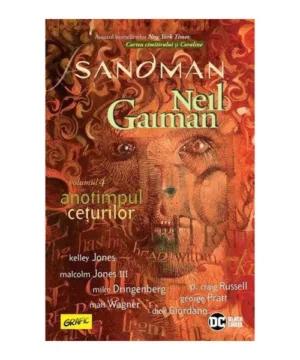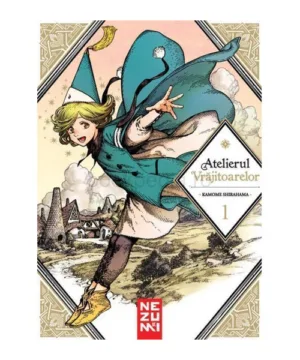Language and Symbols in Contemporary Fiction
31,50 lei
| Authors | Alexandra Marginean |
|---|---|
| Publisher | Universitara |
| Year | 2020 |
| Pages | 430 |
Informații suplimentare
| General | |
|---|---|
| Authors | Alexandra Marginean |
| Publisher | Universitara |
| Year | 2020 |
| Others | |
| Identification | |
| ISBN-13 | 9786062812263 |
| Format | |
| Pages | 430 |
Descriere
It would perhaps be unnecessary to argue that literature mirrors mentalities, as it is intuitive and somewhat universally acknowledged. It is the thought that lies at the foundation of this book. I have studied various pieces of literature in order to uncover commonplaces in the mindsets that they put forth. One of the ideas that I have pursued in writing the research was looking into the way in which people from very different backgrounds envisaged reality. My interest was to determine what haunted them, in terms of topics and ideas. It was important to see if they had the same or dissimilar obsessions, coming from various cultures and upbringings. Which is why I chose authors from several continents, with different origins. Also, I have concentrated on works from the last few years, ranging from 2016 to 2018, to justify the timeline that I called “contemporary” in the title. Moreover, I picked novels with more complex imagery and approaching a diversity of themes, avoiding too simple or focused ones – which is visible in the considerable number of pages that they all have as well (even though this was not, of course, a criterion in itself, it was just that it indeed pointed to and reflected complexity of topics as well).
Guillermo del Toro is Mexican and has completed his academic studies in Guadalajara. He has also been raised a Catholic, but from his statements in interviews he demonstrates that he is not one in the traditional sense, as he is not really a Christian or a believer either (Guillermo del Toro, n. d., Wikipedia, https://en. wikipedia. org/wiki/Guillermo_del_Toro). This does not take away his spirituality, though, as he believes in epiphany at the dawn of one’s life, the moment one leaves this world (ibidem). With such a profile, his ideas are borderline and challenging, and what seems clear is that he has a preoccupation with the spiritual in an original acceptation of the term, and with fringe concepts, ideas, images and thinking in general. He also views the horror as political, in both the sense that it represents traumatizing oppression potentially engendering monstrosity, and in being the manifestation of protest against authority (going beyond it) and of anarchy (ibidem). The co-author of The Shape of Water, Daniel Kraus, is American, and known for various children and young adult’s books, which share the elements of fantasy and the supernatural, as well as the use of monstrous beings as characters (Daniel Kraus, n. d., Wikipedia, https://en. wikipedia. org/wiki/Daniel_Kraus_(author)). His collaboration with del Toro began before The Shape of Water, in Trollhunters, later made into an animated series (ibidem).
Zadie Smith is born and educated in London, moreover at Cambridge, also having become a teacher of fiction at Columbia University of New York in her adult years, after previously authoring an anthology as a result of her writer-in-residence time at the Institute of Contemporary Arts in London (Zadie Smith, n. d., Wikipedia, https://en. wikipedia. org/wiki/Zadie_Smith). In America, she has also collaborated to “polish” language in film dialogues, as a guest-editor with BBC Radio 4, and as a book reviewer for renowned New York magazines (ibidem). All of these occupations rely on a mastery of English that makes her a representative person for Englishness in this respect. However, there is yet another facet of her personality, which reminds us of her being half-Jamaican, as her mother was born and raised in Jamaica, and only immigrated to England as a teenager. This origin perhaps manifested itself in her desire to change her first name, Sadie, to Zadie, when she was fourteen (ibidem). The latter sounds more Caribbean, reflecting the predilection for voiced consonants, the existence of names beginning with “Z” (6 in the list I have consulted), and central and back vowels, often in diphthongs, encountered in women’s first names in this region (Jamaican Baby Girl Names, 2017, http://www. babynames. org. uk/jamaican-girl-baby-names. htm), unlike Sadie, which reflects the preference for more subdued sonority and consonants in girls’ names, for the letter “s” either at the beginning or in the middle of the name, and for the diphthong “/eɪ/” and front-close vowel “/i/”, as it is visible in a study on most popular names in the seventies (when the author was born), where there is no name beginning with a “Z” in the list, and nearly no names to contain a “z” (other than Elizabeth, which ranks 12, probably due to the popularity of actress Elizabeth Taylor, and Suzanne, which ranks only 107) (Popular names of the period 1970s, 2019, Social Security, https://www. ssa. gov/oact/babynames/decades/names1970s. html).
Also, Zadie Smith liked tap dancing and considered acting in musicals, as well as earned money as a jazz singer in her academic years – both preoccupations rooted in African culture (Zadie Smith, n. d., Wikipedia, https://en. wikipedia. org/wiki/Zadie_Smith). Smith has often made public photographs and appearances wearing a scarf around her head, like a turban.
If we add to that the fact that two of her brothers are rappers (ibidem), we understand that her mother’s background has been preserved as a vein in the children’s education. If Zadie Smith did not reflect more her roots with her occupation, she certainly reflected them in the above-mentioned manifestations and in the topics that she chose in her fiction.
Haruki Murakami is of Japanese descent. Some elements that may have influenced both him as a person and his work are: his parents’ teaching of Japanese literature, which gave him a taste for being an intellectual; his (perhaps resulting) interest in reading literature of all origins (American, European and Russian alike); the war trauma that affected his father (subsequent to his involvement in the Sino-Japanese conflict) and which indirectly also impacted him and could have been reflected in the tendency towards depression in his characters (Haruki Murakami, n. d., Wikipedia, https://en. wikipedia. org/wiki/Haruki_Murakami).
Murakami has been considered less Japanese in his writing by some voices, because of the influence of foreign works in his (ibidem). Then again, we could also argue that the Japanese elements that exist in his literature are most relevant precisely due to having been selected among many by an aware, informed writer, whose choice, in the context of knowledgeability of other trends and literary realities, makes them all the more salient and valuable.
Looking, finally, on the European continent, I have chosen for this study Olivia Sudjic, who is British English, and much younger than the other writers, which made her a good candidate for observing youth culture preoccupations and potential problems from the inside, as it were. Which she investigates, in her debut novel, Sympathy, published at the age of 29, where she compares the space of fiction with that of social media – a clear, central concern in her work – because, as the author points out herself, the protagonist in a story is just as unknown and unpredictable as one in the virtual environment, and people tend to project their own perspective on both, in the absence of a tangible reality (Olivia Sudjic, n. d., Wikipedia, https://en. wikipedia. org/wiki/Olivia_Sudjic)(…)
The method of analysis is, as usual in what I write, a mélange. I have resorted to identity studies, cultural studies, visual studies, iconology, space and city studies, interculturalism, as well as gender or minority studies. Also, psychology or sociology cannot be missing from an interest that is, primarily, in human identity and culture. This blended approach is the one I consider the most suitable, because I have always been of the opinion that the logic of the tools is, and/or should be, dictated by the elements that are present in the object of the study. It is those that point to certain kits, not the other way around. I have never established for my extensive researches one kit or another as a definite instrument set in stone when I have looked at a cultural product, as I feel that I would be implicitly bent towards partiality of interpretation, to a limited viewing angle. I believe it is important to allow the cultural object to speak, to have its own voice as it were, and only then see what avenues of analysis it opens and favors – I use here the verb “favors”, as the search for the ingredients of a work of art is also a question of ration, not only presence, i. e. we identify what is preponderant, where the scales tip more, towards what recurrent aspects. For the sake of the faithfulness and open mindedness owed to the object of my glance, I find it difficult to limit myself to only one theoretical approach, especially in a world in which boundaries have been, are, and will be questioned to an incredibly high degree. And I refer here chiefly to cultural boundaries, but not only to these.
















